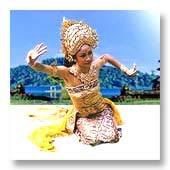In old days there is no woman drinks arak or tuak but with the passing of the time women start to drink tuak but never arak (too strong for woman) it is not discrimination, Balinese believe that arak is dangerous for womb. Women usually drink tuak secretly or in house compound not in public (warung stalls, on the road side, or balai banjar/sub village public hall) as men do.
Drinking for Balinese is usually for recreational purposes. We drink to strengthen the friendship among friends and to make a friend among strangers. There is an old saying among teenagers, it runs “cigarette and liquors are tools for making friends. It is common for Balinese to invite a stranger to join a “drink circle”. (We usually sit in a circle while drinking).We seldom drink for stress relieving purpose or Drink for Drunk (drink for the sake of getting drunk) drinking for recreational purpose can be a very creative way of drinking. Balinese usually sing while drinking, this habit originated genjek tradition.
 Genjek is a traditional form of singing in which a group of men (usually 6 to12) sitting in a circle, some of them singing, while the rest of them imitating the sound of musical instruments. The songs are mainly about love and everyday life. Genjek is usually performed in wedding ceremony. The genjek performers have to be half drunk before the show begin. It is believed that the quality of the song depends on the level of intoxication of the performers. High level of intoxication means a high quality song.
Genjek is a traditional form of singing in which a group of men (usually 6 to12) sitting in a circle, some of them singing, while the rest of them imitating the sound of musical instruments. The songs are mainly about love and everyday life. Genjek is usually performed in wedding ceremony. The genjek performers have to be half drunk before the show begin. It is believed that the quality of the song depends on the level of intoxication of the performers. High level of intoxication means a high quality song. In drinking Balinese have a certain code of conduct such as an offering of small quantity of liquor have to be made before Balinese start to drink. We usually pour a small amount of drink on the ground or floor in order to pacify bhuta kala (negative nature force) so it will not disturb the drinking activity. The way of drinking tuak is slightly different with arak. In drinking tuak every participant has his own kélé (a mug made of bamboo) and uses it privately. While in drinking arak we use only one small glass for all the participants, we drink in turn. An exception is made when someone from higher caste (Brahmana, Ksatrya, or Weysya) join the circle, an offer to use a private glass have to be made. An offer for private glass is a sign of respect for him. We welcome him into the circle whether he use private glass or not. An offer to taste a glass of arak for passing stranger is often made. If you want it, do not hesitate take it as soon as it is offered. Say thank you if you do not want to join the circle. If you want to join the circle, ask for it after you finish the offered drink. If you do not want to taste the offered liquor, refuse it with a good reason. Medical or religious prohibition is the best excuse.
In drinking Balinese have a certain code of conduct such as an offering of small quantity of liquor have to be made before Balinese start to drink. We usually pour a small amount of drink on the ground or floor in order to pacify bhuta kala (negative nature force) so it will not disturb the drinking activity. The way of drinking tuak is slightly different with arak. In drinking tuak every participant has his own kélé (a mug made of bamboo) and uses it privately. While in drinking arak we use only one small glass for all the participants, we drink in turn. An exception is made when someone from higher caste (Brahmana, Ksatrya, or Weysya) join the circle, an offer to use a private glass have to be made. An offer for private glass is a sign of respect for him. We welcome him into the circle whether he use private glass or not. An offer to taste a glass of arak for passing stranger is often made. If you want it, do not hesitate take it as soon as it is offered. Say thank you if you do not want to join the circle. If you want to join the circle, ask for it after you finish the offered drink. If you do not want to taste the offered liquor, refuse it with a good reason. Medical or religious prohibition is the best excuse. In eastern part of Bali, tuak is a substitution for water. An offer of drinking tuak is a part of politeness there. It is considered to be impolite to turn down the offer without a proper apology and a good reason. Again, Medical or religious prohibition is a preferred excuse to hear by the host. But accepting the offer will be a perfect way to interact with the community.
In eastern part of Bali, tuak is a substitution for water. An offer of drinking tuak is a part of politeness there. It is considered to be impolite to turn down the offer without a proper apology and a good reason. Again, Medical or religious prohibition is a preferred excuse to hear by the host. But accepting the offer will be a perfect way to interact with the community.Arak - distilled, colorless, fiery palm or rice brandy distilled from tuak; the fermented milk of the coconut or lontar palm.












